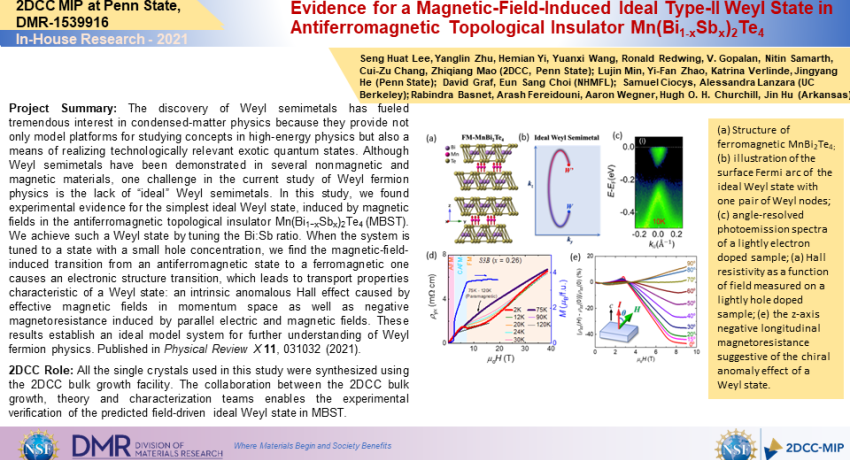Project Summary: The discovery of Weyl semimetals has fueled tremendous interest in condensed-matter physics because they provide not only model platforms for studying concepts in high-energy physics but also a means of realizing technologically relevant exotic quantum states. Although Weyl semimetals have been demonstrated in several nonmagnetic and magnetic materials, one challenge in the current study of Weyl fermion physics is the lack of “ideal” Weyl semimetals. In this study, we found experimental evidence for the simplest ideal Weyl state, induced by magnetic fields in the antiferromagnetic topological insulator Mn(Bi1−xSbx)2Te4 (MBST). We achieve such a Weyl state by tuning the Bi:Sb ratio. When the system is tuned to a state with a small hole concentration, we find the magnetic-field-induced transition from an antiferromagnetic state to a ferromagnetic one causes an electronic structure transition, which leads to transport properties characteristic of a Weyl state: an intrinsic anomalous Hall effect caused by effective magnetic fields in momentum space as well as negative magnetoresistance induced by parallel electric and magnetic fields. These results establish an ideal model system for further understanding of Weyl fermion physics. Published in Physical Review X 11, 031032 (2021).
2DCC Role: All the single crystals used in this study were synthesized using the 2DCC bulk growth facility. The collaboration between the 2DCC bulk growth, theory and characterization teams enables the experimental verification of the predicted field-driven ideal Weyl state in MBST.
What Has Been Achieved: The simplest ideal Weyl State in ferromagnetic (FM) phase of Sb-doped MnBi2Te4 has been demonstrated via transport measurements. This state is found to be sensitive to carrier density and can be accessible via tuning the Bi:Sb ratio.
Importance of the Achievement: This work establishes an ideal model system for further understanding of Weyl fermion physics .
Unique Feature(s) of the MIP that Enabled this Achievement: The 2DCC bulk growth succeeded in growing Mn(Bi1−xSbx)2Te4 crystals with controlled carrier type and density, which played a critical role in this work. The close collaboration between the 2DCC bulk growth, theory and characterization teams further facilitates this work. The National High Magnetic Field facility also played an important role in this work. The field-driven electronic transition from the topological insulator to the ideal Weyl semimetal was revealed by high-field Hall resistivity measurements.
(If Applicable) Publication:
Seng Huat Lee, David Graf, Lujin Min, Yanglin Zhu, Hemian Yi, Samuel Ciocys, Yuanxi Wang, Eun Sang Choi, Rabindra Basnet, Arash Fereidouni, Aaron Wegner, Yi-Fan Zhao, Katrina Verlinde, Jingyang He, Ronald Redwing, V. Gopalan, Hugh O. H. Churchill, Alessandra Lanzara, Nitin Samarth, Cui-Zu Chang, Jin Hu, and Z. Q. Mao, Physical Review X 11, 031032 (2021). DOI:10.1103/PhysRevX.11.031032
We thank C. X. Liu for helpful discussions. The study is based upon research conducted at The Pennsylvania State University Two-Dimensional Crystal Consortium–Materials Innovation Platform (2DCC-MIP), which is supported by National Science Foundation (NSF) Cooperative Agreement No. DMR-1539916. Z. Q. M. acknowledges the support from the U.S. National Science Foundation under Grant No. DM-1917579. J. H. acknowledges the U.S. Department of Energy (DOE), Office of Science, Basic Energy Sciences program under Grant No. DE-SC0019467 for the support of magnetization, quantum oscillation, and 31 T high field transport measurements. The work at the National High Magnetic Field Laboratory is supported by the NSF Cooperative Agreement No. DMR 1644779 and the State of Florida. L. M., J. H., and V. G.’s work is supported by the Penn State Center for Nanoscale Science, an NSF MRSEC under Grant No. DMR-2011839. C. Z. C., H. Y., and Y. F. Z. acknowledge the support from the DOE Grant (No. DESC0019064) and the NSF-CAREER grant (No. DMR1847811) for ARPES measurements at Penn State. The ARPES experiment at Berkeley was supported by the U.S. Department of Energy, Office of Science, Basic Energy
Sciences, Materials Sciences and Engineering Division under Contract No. DE-AC02-05-CH11231 within the Quantum Material Program (KC2202). This experiment was performed by S. C. advised by A. L. and utilized the Advanced Light Source, a DOE Office of Science User Facility under Contract No. DE-AC02-05CH11231.
